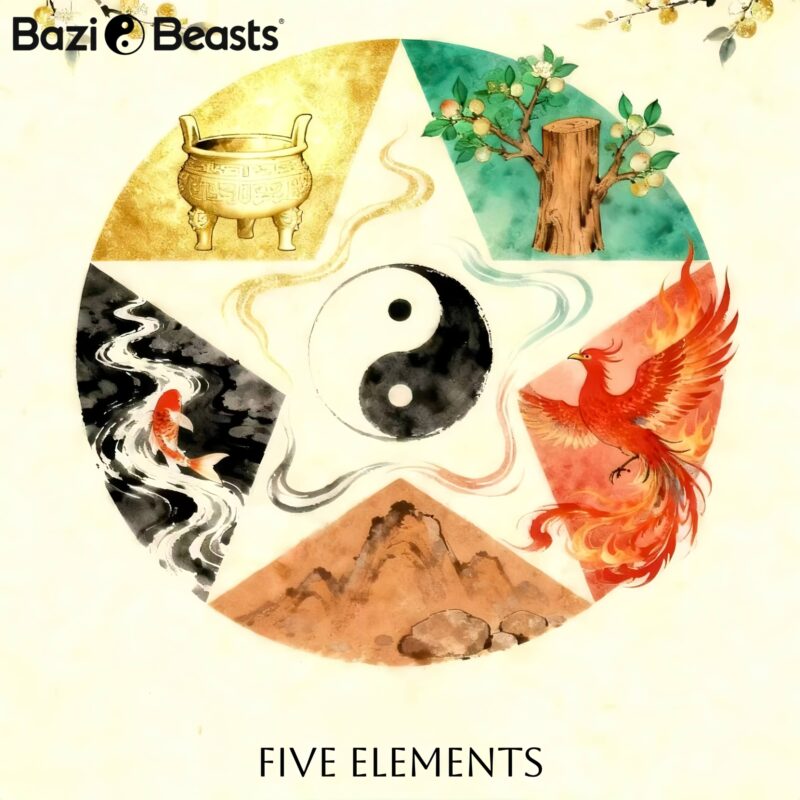Introduction to the Five Elements

The Five Elements (Wuxing) is one of the core concepts in traditional Chinese philosophy, referring to five material forms: Metal, Wood, Water, Fire, and Earth. Ancient Chinese believed these were the basic elements composing all things in the universe, and their interactions drive the development and changes of matters.
1. Basic Attributes of the Five Elements
Each element corresponds to specific natural phenomena, seasons, directions, and characteristics, which are the foundation for understanding their functions.
| Five Elements | Corresponding Direction | Corresponding Season | Core Characteristics | Common Associations |
|---|---|---|---|---|
| Wood | East | Spring | Growth, expansion, stretching | Plants, trees, vitality |
| Fire | South | Summer | Heat, upward movement, brightness | Flame, sunlight, passion |
| Earth | Center | End of the four seasons (Chen, Xu, Chou, Wei months) | Bearing, nurturing, stability | Earth, soil, tolerance |
| Metal | West | Autumn | Convergence, restraint, solidity | Metals, ores, harvesting |
| Water | North | Winter | Coldness, downward movement, moisture | Rivers, rain and snow, wisdom |
2. Core Relationships of the Five Elements
The Five Elements do not exist in isolation. Instead, they maintain the balance and circulation of the system through two basic relationships: “mutual generation” and “mutual restriction”.
1. Mutual Generation (Promotion and Nurturing)
It means one element has the effect of assisting the growth of another. The order is “Wood generates Fire → Fire generates Earth → Earth generates Metal → Metal generates Water → Water generates Wood”, forming a positive cycle.
- Wood generates Fire: Wood can be ignited to produce flames, such as “making fire by drilling wood”.
- Fire generates Earth: Ashes from burned flames turn into soil, nourishing the earth.
- Earth generates Metal: Metal ores are buried in the soil and need to be mined from it.
- Metal generates Water: Metals condense into water droplets at low temperatures, or metal tools can dig and divert water sources.
- Water generates Wood: Water can nourish plants and make trees grow luxuriantly.
2. Mutual Restriction (Restraint and Balance)
It means one element has the effect of restraining another. The order is “Wood restricts Earth → Earth restricts Water → Water restricts Fire → Fire restricts Metal → Metal restricts Wood”, forming a reverse checks-and-balances cycle.
- Wood restricts Earth: Plant roots can break through the soil, absorb nutrients from it, and change the soil structure.
- Earth restricts Water: Soil can be used to build dikes to block water and prevent floods, which is known as “using earth to hold back water”.
- Water restricts Fire: Water can put out flames and control the spread of fire.
- Fire restricts Metal: High-temperature flames can melt metals and change their forms.
- Metal restricts Wood: Metal tools (such as axes and saws) can cut down trees and stop the growth of Wood.
3. Application Fields of the Five Elements
The theory of the Five Elements is not just a philosophical concept, but penetrates into multiple fields of traditional Chinese culture and becomes a practical analytical tool.
- Traditional Chinese Medicine (TCM): It corresponds the human zang-fu organs to the Five Elements (e.g., the liver belongs to Wood, the heart to Fire, the spleen to Earth, the lungs to Metal, and the kidneys to Water), and treats diseases by regulating the balance of the Five Elements.
- Fortune-telling and Feng Shui: The Five Elements serve as the core analytical framework in fortune-telling theories like Four Pillars of Destiny and Zi Wei Dou Shu, as well as in Feng Shui theories for housing and environmental layout.
- Traditional Culture and Art: The color matching in ancient architecture, costumes, and paintings (e.g., using cyan (belonging to Wood) for the east and red (belonging to Fire) for the south) often takes the Five Elements as the basis.


